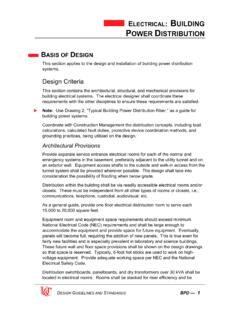Transcription of GUIDANCE NOTES FOR SOLAR PHOTOVOLTAIC (PV) SYSTEM …
1 1 GUIDANCE NOTES for SOLAR PHOTOVOLTAIC (PV) SYSTEM Installation January 2019 GUIDANCE NOTES FORSOLAR PHOTOVOLTAIC (PV) SYSTEM INSTALLATIONJ anuary 2019 GUIDANCE NOTES FORSOLAR PHOTOVOLTAIC (PV) SYSTEM INSTALLATIONThe Government of the Hong Kong Special Administrative Region does not accept any liability and responsibility for loss or damage caused due to reliance on any information or omission in the content of this publication, including but not limited to all text, graphics, drawings, diagrams, photographs and compilation of data or other materials are protected by copyright. The Government of the Hong Kong Special Administrative Region is the owner of all copyright works contained in this publication. Any infringement of copyright, including but not limited to reproduction, adaptation, distribution, dissemination or making available of such copyright works to the public is strictly prohibited unless prior written authorisation is obtained from the Electrical and Mechanical Services NOTICEC hinese of Contents1 Foreword 12 Glossary of Terms and Abbreviations 33 Introduction 6 4 Major Components of SOLAR PV SYSTEM 8 SOLAR PV Panel 9 Inverter 10 5 Installation Requirements 11 General Requirements 12 Installation of SOLAR PV Systems in New Territories Exempted Houses 13 (NTEH) (commonly known as village houses)
2 Installation of SOLAR PV Systems in Private Buildings 15 Installation of SOLAR PV Systems in Idle Land 16 Other Suggestions for Consideration 17 6 Regulatory Requirements 18 Requirements in relation to Electricity safety 19 Requirements in relation to Building safety 20 Recommendations in relation to fire safety 21 Requirements in relation to Business Registration and Tax Return 227 Operation and Maintenance 23 8 Outline of Application Procedures of Feed-in Tariff (FiT) 25 9 Local and Overseas Standards 27 10 Enquires 29 Appendices 31 Appendix 1 32 Flowchart for Installation of SOLAR PHOTOVOLTAIC Systems in New Territories Exempted Houses (NTEH) (commonly known as village houses)Appendix 2 34 Flowchart for Installation of SOLAR PHOTOVOLTAIC Systems in Private BuildingsAppendix 3 36 Flowchart on key application procedures involved in applying for Feed-in Tariff (FiT)Appendix 4 37 Local and Overseas Standards and Best PracticesTable of ContentsGUIDANCE NOTES FORSOLAR PHOTOVOLTAIC (PV) SYSTEM INSTALLATION To assist the public to better understand the issues related to SOLAR PV SYSTEM installations and the FiT application procedures, a Working Group was formed in 2018 with members from Environment Bureau (ENB), Electrical and Mechanical Services Department (EMSD), Lands Department (LandsD), Planning Department (PlanD), Buildings Department (BD) and fire Services Department (FSD) to develop the GUIDANCE NOTES for SOLAR PHOTOVOLTAIC (PV)
3 SYSTEM This set of GUIDANCE NOTES (hereinafter referred to as "the NOTES ") provides general guidelines for intending purchasers, owners and installers of SOLAR PV systems to understand the installation requirements and FiT application procedures associated with the installation, operation and maintenance of such The intending purchasers, owners and installers may also make reference to "Technical Guidelines on Grid Connection of Renewable Energy Power Systems" which explains the technical issues and the application procedures relating to grid connection of small-scale renewable energy installations. The technical guidelines can be downloaded from the website of the Electrical and Mechanical Services Department at The NOTES will be reviewed regularly. The EMSD welcomes suggestions for improving the NOTES .
4 First issue : October 2018 This revision : January 20192 GUIDANCE NOTES for SOLAR PHOTOVOLTAIC (PV) SYSTEM Installation 1 FOREWORDGUIDANCE NOTES FORSOLAR PHOTOVOLTAIC (PV) SYSTEM INSTALLATION 2 GLOSSARY OF TERMS AND ABBREVIATIONS4 GUIDANCE NOTES for SOLAR PHOTOVOLTAIC (PV) SYSTEM Installation TermsDefinitionApproved loadingThe maximum current demand approved by a power company in respect of a fixed electrical Power RatingThe arithmetic sum of the power rating of each item of power generating equipment of all the Renewable Energy Power Systems (REPSs) installed in each location or in each building, irrespective of whether they are installed by the landlord or PersonIt means a person whose name is on the authorized persons' register kept under section 3(1) of the Buildings Ordinance (Cap. 123)-(a) as an architect;(b) as an engineer.
5 Or (c) as a current revised edition of the Code of Practice for the Electricity (Wiring) Regulations issued by the Electrical and Mechanical Services SystemThe on-site 220/380V low-voltage electricity supply network operated by the site owner or the site management equipmentMachines, transformers , apparatus, appliances, measuring instruments, protective devices, wiring materials, accessories, fittings and similar things, used for generation, conversion, transmission, distribution, control, measurement or utilisation of electrical installationAn assembly of associated electrical OrdinanceChapter 406 of the Laws of Hong Kong, which is enforced by the Electrical and Mechanical Services Department regulating electrical workWork in relation to the installation, commissioning, inspection, testing, maintenance.
6 Modification or repair of a low voltage or high voltage fixed electrical installation and includes the supervision and certification of that work and the certification of design of that OF TERMS AND ABBREVIATIONS2 GLOSSARY OF TERMS AND ABBREVIATIONS5 GUIDANCE NOTES for SOLAR PHOTOVOLTAIC (PV) SYSTEM Installation TermsDefinitionFixed electricalinstallationA low or high voltage electrical installation that is fixed to premises but does not include any electrical equipment that is supplied with electricity after passing through a socket of the installation at which the supply can be disconnected without the use of a 220/380V low-voltage electricity supply network operated by the power (Note: Theinterpretation on the right is only applicable to electricalinstallations)(a) A person who is in possession or control of an electrical installation; and(b) A person who holds premises in which an electrical installation is located, whether the premises are held under lease, licence or otherwise and includes an agent of that person and a tenant or occupier of premises.
7 Registered ElectricalContractorAn electrical contractor registered under section 33 of the Electricity Ordinance (Cap. 406).Registered ElectricalWorkerAn electrical worker registered under section 30 of the Electricity Ordinance (Cap. 406).New Territories Exempted Houses (NTEH) ( commonly known as village houses)NTEH generally refer to those village houses situated in the New Territories which by virtue of the Buildings Ordinance (Application to the New Territories) Ordinance are exempted from certain provisions of the Buildings Ordinance and its subsidiary regulations, including the need for obtaining prior approval for and consent to the commencement of works from the BD. NTEH are in general designed and built in compliance with the exemption criteria in respect of the height and roofed-over area, etc.
8 Stipulated in the Buildings Ordinance (Application to the New Territories) which thus qualify them for exemption. For example, new housing should be of not more than 3 storeys and of a height of not more than m (about 27 feet) and with a roofed-over area not exceeding m2 (about 700 square feet). GUIDANCE NOTES FORSOLAR PHOTOVOLTAIC (PV) SYSTEM INSTALLATION In the post-2018 Scheme of Control Agreements (SCAs), Feed-in Tariff (FiT) is one of the new initiatives to be introduced to help encourage the private sector to consider investing in Renewable Energy (RE) as the power generated could be sold to the power companies at a rate higher than the normal electricity tariff rate to help recover the costs of investment in the RE systems and generation. Taking into consideration the RE potential in Hong Kong, FiT will be offered to SOLAR PV systems as well as wind power Except for government bodies, all customers of the power companies who plan to install SOLAR PV systems and/ or wind power systems with a generating capacity of up to 1 MW at their premises in the respective power company's supply area are eligible for prescribed FiT rates from that power company based on the units of electricity generated, as long as the distributed RE systems are connected to the grid of the relevant power company subject to FiT Terms and Conditions.
9 RE systems with a generating capacity exceeding 1 MW will be considered on a case-by-case It is not allowed to connect the REPS with any non-renewable energy source or energy storage facility, which will affect the reading of the FiT meter for measuring electricity generated from the REPS. Based on this principle, any energy storage facility must not be connected on the REPS side before the FiT Capital cost of SOLAR PV systems varies according to the generating capacity and PV panel technology. Generally speaking, the capital cost of a SOLAR PV SYSTEM is around tens of thousands dollars per kilowatt, covering costs of labour and inspection, structural support, inverter, PV modules and associated electrical installations, NOTES for SOLAR PHOTOVOLTAIC (PV) SYSTEM Installation 3 INTRODUCTIONGUIDANCE NOTES FORSOLAR PHOTOVOLTAIC (PV) SYSTEM INSTALLATION 4 MAJOR COMPONENTS OF SOLAR PV SOLAR PV Panel(i) In general, the SOLAR PV panels that can be found in the market are built up by three major types of SOLAR cells (or SOLAR modules) monocrystalline cells, polycrystalline cells or thin film cells.
10 The energy conversion efficiency and price of the three types of SOLAR PV panels are different. Intending purchasers, owners and installers may purchase the appropriate type of SOLAR PV panels according to the design of SOLAR PV SYSTEM and their budget. In general, the energy conversion efficiency and the cost of monocrystalline cells are higher than the other two.(ii) When purchasing SOLAR PV panels, intending purchasers, owners and installers should select the SOLAR PV panels designed and manufactured according to relevant international standards or specifications, and so certified by the recognised organisations or relevant testing and certification authorities. Intending purchasers, owners and installers may request suppliers to provide certificates for the design and safety standards of the SOLAR PV panels and other key components, and confirm that the product has met the relevant international standards and provide appropriate period of COMPONENTS OF SOLAR PV SYSTEM9 GUIDANCE NOTES for SOLAR PHOTOVOLTAIC (PV) SYSTEM Installation Inverter(i) Inverter is a key component of a SOLAR PV SYSTEM .


